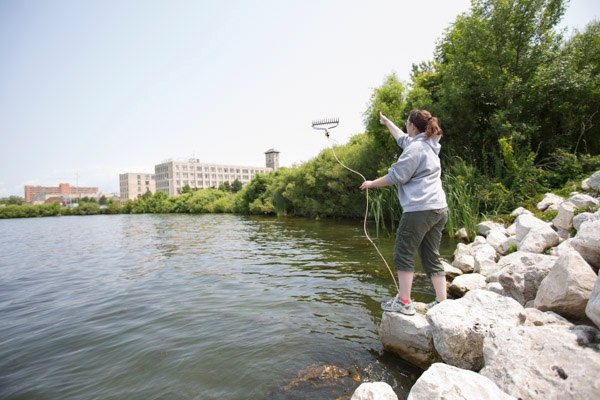In the weeds
Researchers tackle water plant problems with DNA
photos by Bernadine Carey-Tucker video by Jeremy Knickerbocker
In a state with more than 11,000 inland lakes, managing aquatic plants in Michigan is both big business and a sensitive environmental matter.
Sometimes managing the plants means getting rid of weeds near a dock or swimming area, but in other situations management means knowing whether a plant should be removed.
Researchers at Grand Valley’s Robert B. Annis Water Resources Institute in Muskegon are working on a cutting-edge process to help save lakes from environmental damage, save native plants from unnecessary removal, and save money for people who have economic interests in lakes.
The process is based on DNA testing of a particular aquatic plant called a watermilfoil that comes in dozens of varieties. Some are native to Michigan waters, while others are invasive.
Determining each plant’s variety makes removal decisions easier and can directly impact the method or chemical used to remove it, as varieties and hybrids respond very differently to treatments.
“Aquatic plants are the basis of the food chain and create a lot of the structure in a lake as they grow from the bottom to the surface,” said Ryan Thum, a former Grand Valley researcher who led the project. “Aquatic plants are by and large good for lakes, but invasive species can grow out of control. They can grow in densities that native plants can’t reach, or in areas native plants wouldn’t grow. We’re trying to find out when and how an introduced species is going to be invasive, and if it’s going to cause a problem in the lake or not.”
Thum and a group of students, including graduate student Syndell Parks, have been working to determine specific herbicide treatment plans for individual varieties of invasive Eurasian watermilfoil along with the multitudes of hybrids created by crossbreeding
between the eurasian and northern watermilfoil varieties.
Without accurate identification, property owners can pay a hefty price for weed treatment only to find that the herbicide wasn’t effective against their unique variety. With herbicide applications ranging from $350 to $600 per acre of lake, tens of thousands of dollars from special tax assessment districts or lake association dues can be wasted on an ineffective treatment.

AWRI graduate student Syndell Parks throws a collection rake into Muskegon Lake to sample aquatic plants.
“We are providing a genetic testing service — we know that eurasian and northern watermilfoil and their hybrids have unique DNA signatures, and we can use pieces of the genomes of the organisms to work like barcodes,” Thum said. “We can ‘scan’ a piece of DNA and determine the variety, and we’re working on a database of information on each to prescribe an accurate, third-party, objective treatment for that specific lake.”
Ideally, Thum said, a lake association could send a sample to a lab and have a DNA analysis done, and receive a recommendation to give to an aquatic plant management company that indicates precisely how and when to treat that specific weed. A more exact identification would also help prevent putting unnecessarily heavy amounts of herbicide into the water, as some varieties of the hybrid watermilfoil can be treated with half the herbicide as another variety. Currently, specific varieties are hard to pin down, as one hybrid doesn’t necessarily look like any other.
“It would be like looking at a maple tree and an oak tree, but then having six different maple trees and having all of their leaves look different; like a maple or an oak or some sort of cross in between,” said Parks, the graduate student leading the ongoing research on the project. “Not all hybrids look the same. There’s a range of the physical characteristics, along with how they grow and behave and respond. This DNA testing is really the only way to know what you have.”
Properly treating and removing nuisance weeds is critical to homeowners and other stakeholders in lakeshore areas. Two identical properties, one with a lakefront that has been treated for nuisance weeds and one that has not, can be worth significantly different sums. Estimates suggest that properties without weed treatment can be worth as much as 16 percent less compared to the treated property — a significant sum given the price of lakefront real estate in Michigan.

Graduate researcher Syndell Parks removes aquatic plants from a collection rake — two normal garden rakes without handles attached with metal wire.
“They’re protecting their investment. There are recreational qualities for people who want to swim, boat or fish. If you value swimming in your backyard and the water is full of plants, you’re probably not going to swim there, you’re going to get rid of them,” Thum said. “If you’re a property owner of a million-dollar home and piece of land on a lake, this plant potentially has $160,000 of yours on the table. Most owners are happy to take some of that to handle the problem. Every dollar spent on management is between a 10:1 return or above economically. There’s an economic argument that it makes a great deal of sense to do aquatic plant management.”
But not everyone wants to get rid of the plants. Regulatory agencies from state or local governments need to balance the desire for a weed-free property with the benefits of a lake with a healthy native plant population, which includes the northern watermilfoil. The specific identification the DNA test provides is useful to settle disputes between homeowners who want weeds gone and regulators who say the weeds are an important part of the lake ecosystem.
“Regulatory agencies want to manage these natural resources, their mission is to protect them,” Thum said. “They want to preserve the native biodiversity and the ecosystem functions that they serve. There can be tension between homeowners and managers; the benefit our research will have is to make that identification third party and objective.”
The research is so valuable to the general public that Thum and Parks earned grant funding from the National Science Foundation to explore turning the research findings into a private company that would offer the testing service for a fee. The business model is still in the exploratory stages, but the hope is to create an independent company in the future that can help waterfront stakeholders solve problems objectively.
“We want to bring data to the table, and we want to make plant management easier for parties like consultants and regulators and homeowners, some of whom butt heads on this topic,” Parks said. “You can’t argue with numbers and data based on scientific methods.”
Parks said the research will continue in AWRI’s recently updated field station mesocosm facility that allows growth of the watermilfoil year-round as they work to expand the database of different varieties and treatment options for each.
“Part of the reason I came back to Michigan for graduate school was to improve the quality of the information people are using when they’re dealing with the water here. It’s a precious resource that we all have to be stewards of,” Parks said. “You can always learn more, there are always more questions to ask, and there’s always more data to gather. That’s what we’re doing here.”
